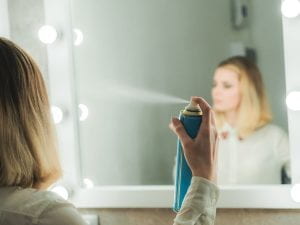Following makeup, skincare, and even body care products, you may be wondering what other beauty products are you going to talk about today. Well, its haircare products! Specifically, how the use of hairsprays contributes to indoor air pollution.
Hairsprays
For the stylists, hairsprays are arguably indispensable because it not only allows you to keep your nicely styled hair in place all day, it can also help with taming your frizz, add volume to your hair and so on (Petal Fresh, 2019). Given its usefulness, hairsprays are widely used.
Yet, the myriad chemicals present in your little handy spray bottle constitutes chemicals that are not environmentally friendly. For instance, propellants are included since hairsprays are often supplied in an aerosol container. The chemicals used to make propellants include Volatile Organic Compounds (VOCs) (Matthews, n.d.) – which plays a significant role in the formation of smog (Environmental Protection Department, 2019). Therefore, every time we do a spray, we are also releasing polluting chemicals.
As hairsprays are mostly used indoors in households or studios, it contributes to indoor air pollution especially with poor or inadequate ventilation as pollutants can accumulate to harmful levels (EPA, 2020).
Indoor Air Pollution
Wait, what?! There is pollution indoors? Yes, in fact, the average home can be up to five times more polluted than the outdoors (Greer, 2019). Despite so, the awareness on it is low since it is less visible to the human eye. However, what you can’t see doesn’t mean it is not there. Its presence needs to be identified and mitigated. This is because indoor air pollution can have adverse health impacts on dwellers.
Exposure to pollutants can lead to immediate effects such as the irritation of the eyes, nose, and throat, headaches, dizziness, and fatigue. Persons with pre-existing respiratory problems may also be triggered such as asthma. Other health effects such as respiratory diseases, heart disease and cancer could also be the result of long-term exposure to pollutants (EPA, 2020).
Find out more about indoor air pollution here.
So, what now?
Quickly open up your windows and doors to increase the ventilation of your space!
References:
Environmental Protection Agency. (2020, August 14). Introduction to Indoor Air Quality. https://www.epa.gov/indoor-air-quality-iaq/introduction-indoor-air-quality
Environmental Protection Department. (2019, May 2). Volatile Organic Compounds and Smog. https://www.epd.gov.hk/epd/english/environmentinhk/air/prob_solutions/vocs_smog.html#point_2
Greer, M. (2019, February 7). 11 Sneaky Causes of Indoor Air Pollution. https://www.besthealthmag.ca/best-you/health/causes-indoor-air-pollution/
Matthews, M. (n.d.) What Is Harmful to the Environment That Is Found in Hairsprays? https://homeguides.sfgate.com/harmful-environment-found-hairsprays-78516.html
Petal Fresh. (2019, April 26). Benefits of Using a Hairspray to Style Your Hair https://petalfresh.com/benefits-of-using-a-hairspray-to-style-your-hair/

